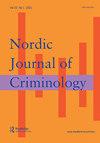Violent men’s paths to batterer intervention programmes: masculinity, turning points and narrative selves
Q2 Social Sciences
引用次数: 14
Abstract
ABSTRACT Drawing on interviews with voluntary participants in intervention programmes for perpetrators of intimate partner violence in Sweden, the present article analyses violent men’s turning-point stories, that is, their narratives of deciding to start and starting treatment. Three types of turning-point stories are identified: narratives that describe men recognizing their violence either before or during treatment, and narratives of returning to treatment. Through these stories, the men not only present reasons for joining therapy, but also produce gendered narrative selves. In particular they present themselves as morally ‘good’ and self-conscious men by simultaneously acknowledging their abusive behaviour and distancing themselves from being violent men.暴力男性进入施暴者干预计划的路径:男子气概、转折点和叙事自我
通过对瑞典亲密伴侣暴力施暴者干预项目自愿参与者的访谈,本文分析了暴力男性的转折点故事,即他们决定开始和开始治疗的叙述。确定了三种类型的转折点故事:描述男性在治疗前或治疗期间认识到自己遭受暴力的叙述,以及返回治疗的叙述。通过这些故事,男性不仅呈现了参加治疗的理由,也产生了性别化的叙事自我。特别是,他们通过同时承认自己的虐待行为并使自己远离暴力行为,将自己表现为道德上的“好人”和自觉的人。
本文章由计算机程序翻译,如有差异,请以英文原文为准。
求助全文
约1分钟内获得全文
求助全文

 求助内容:
求助内容: 应助结果提醒方式:
应助结果提醒方式:


